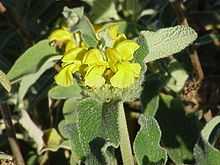Phlomis
| Phlomis | |
|---|---|
 | |
| Phlomis fruticosa | |
| Scientific classification | |
| Kingdom: | Plantae |
| (unranked): | Angiosperms |
| (unranked): | Eudicots |
| (unranked): | Asterids |
| Order: | Lamiales |
| Family: | Lamiaceae |
| Genus: | Phlomis |
| Species | |
|
100+, see text | |
| Wikimedia Commons has media related to Phlomis. |
| Wikispecies has information related to: Phlomis |
Phlomis is a genus of over 100 species[1] of herbaceous plants, subshrubs and shrubs in the family Lamiaceae, native from the Mediterranean region east across central Asia to China. Common names include Jerusalem sage and lampwick plant.
The overall size varies between species from 30 cm tall up to 2 m tall. The leaves are entire, opposite and decussate (each leaf pair at right angles to the next) and rugose or reticulate veined. The bracts (floral leaves) are similar or different from the lower leaves. All parts are frequently covered with hairs. The bracteoles are ovate, lanceolate or linear. The flowers are arranged in whorls called verticillasters which encircle the stems. The stems are usually square in section with rounded corners, although tomentum on the stems can make them appear circular. The colour of the flowers varies from yellow to pink, purple and white. The calyx is tubular or campanulate with five or ten veins visible. Five teeth, either all equal or with the outer two longer than the others. The upper lip is hood shaped and laterally compressed (P. tuberosa, however, has an uncompressed lip with a dense bearded edge). The lower lip is trifid, the central lobe being larger than the lateral ones. There are four stamens ascending under the upper lip. Anther with forked end, the upper fork being shorter than the lower. The fruits are four three-sided, nutlets, and sometimes topped with hair, sometimes glabrous. The root system can be very extensive; roots of 6-week-old seedlings have been measured at 0.7 m.
The name Phlomis derives from a Greek word for "flame", and may refer to the leaves' use in ancient times as lamp wicks.[2]
Phlomis species are the only host plants of the moths Coleophora phlomidella and C. phlomidis.
Diversity
- Phlomis alpina
- Phlomis armeniaca
- Phlomis betonicoides
- Phlomis bovei
- Phlomis bracteosa
- Phlomis cashmeriana
- Phlomis chrysophylla
- Phlomis crinita
- Phlomis fruticosa - Jerusalem sage
- Phlomis grandiflora
- Phlomis herba-venti
- Phlomis inaequalisepala
- Phlomis italica
- Phlomis lanata
- Phlomis longifolia
- Phlomis lychnitis - lampwick plant
- Phlomis lycia
- Phlomis macrophylla
- Phlomis maximowiczii
- Phlomis melanantha
- Phlomis milingensis
- Phlomis oreophila
- Phlomis pratensis
- Phlomis purpurea
- Phlomis rigida
- Phlomis rotata
- Phlomis russeliana
- Phlomis samia
- Phlomis spectabilis
- Phlomis tuberosa
- Phlomis umbrosa
- Phlomis viscosa
- Phlomis younghusbandii
References
- ↑ 1.0 1.1 Phlomis. Flora of China.
- ↑ Coombes, A. J. (2012). The A to Z of Plant Names. USA: Timber Press. p. 312.
- ↑ GRIN Species Records of Phlomis. Germplasm Resources Information Network (GRIN).